Alginate and Algal-Based Beads for the Sorption of Metal Cations: Cu(II) and Pb(II)
Abstract
:1. Introduction
2. Results and Discussion
2.1. SEM-EDX Analysis
2.2. Effect of pH on Metal Sorption
2.3. Effect of the Composition of the Solution
2.4. Sorption Isotherms
2.5. Uptake Kinetics
3. Materials and Methods
3.1. Materials
3.2. Reagents
3.3. Methods
3.3.1. Preparation of Sorbents
3.3.2. Metal Solutions and Measurement
3.4. Sorption Process
3.4.1. Effect of pH
3.4.2. Effect of Coexisting Ions
3.4.3. Sorption Isotherm
3.4.4. Kinetic Study
3.5. Statistic Methods
4. Conclusions and Perspectives
Supplementary Materials
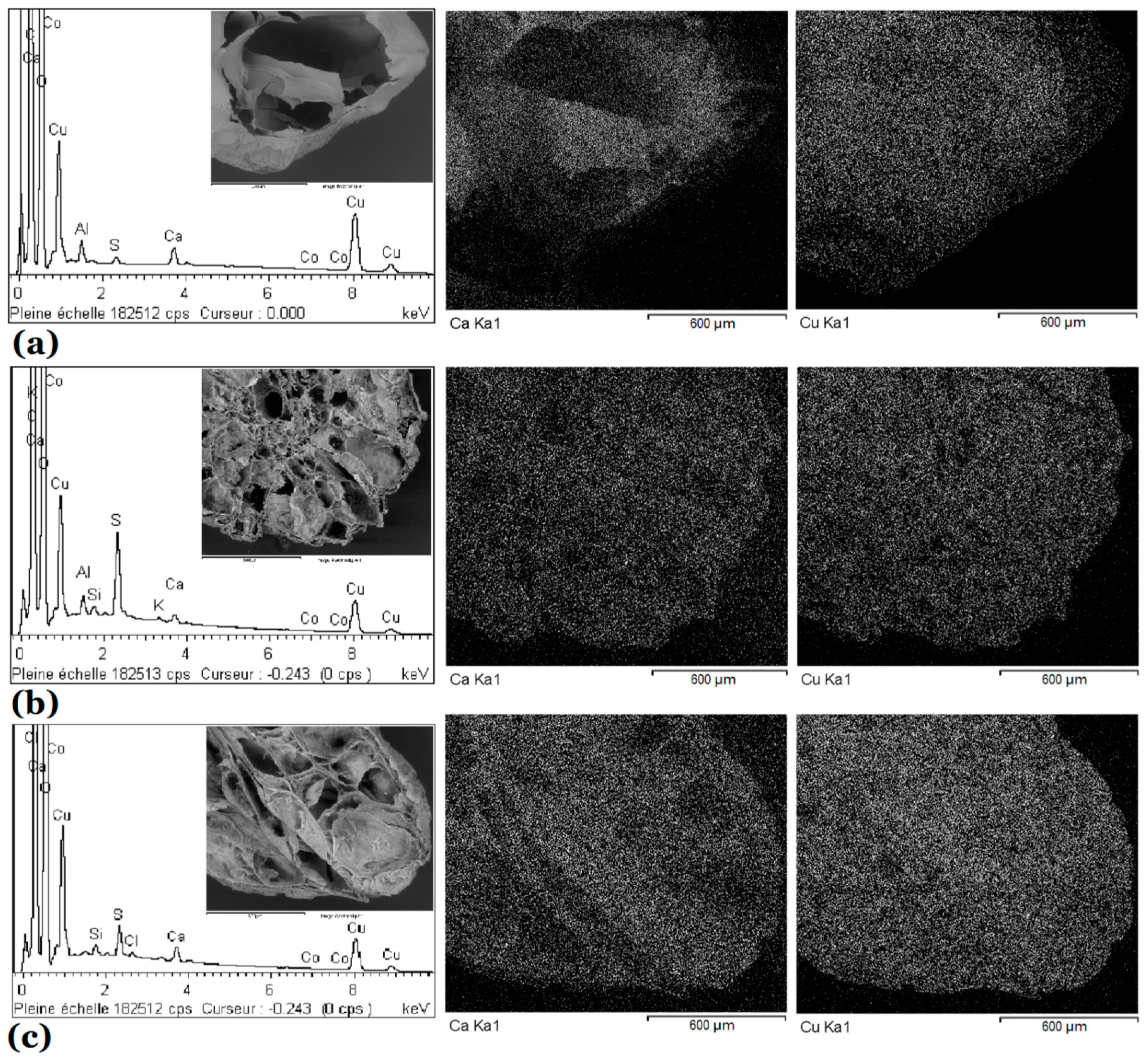

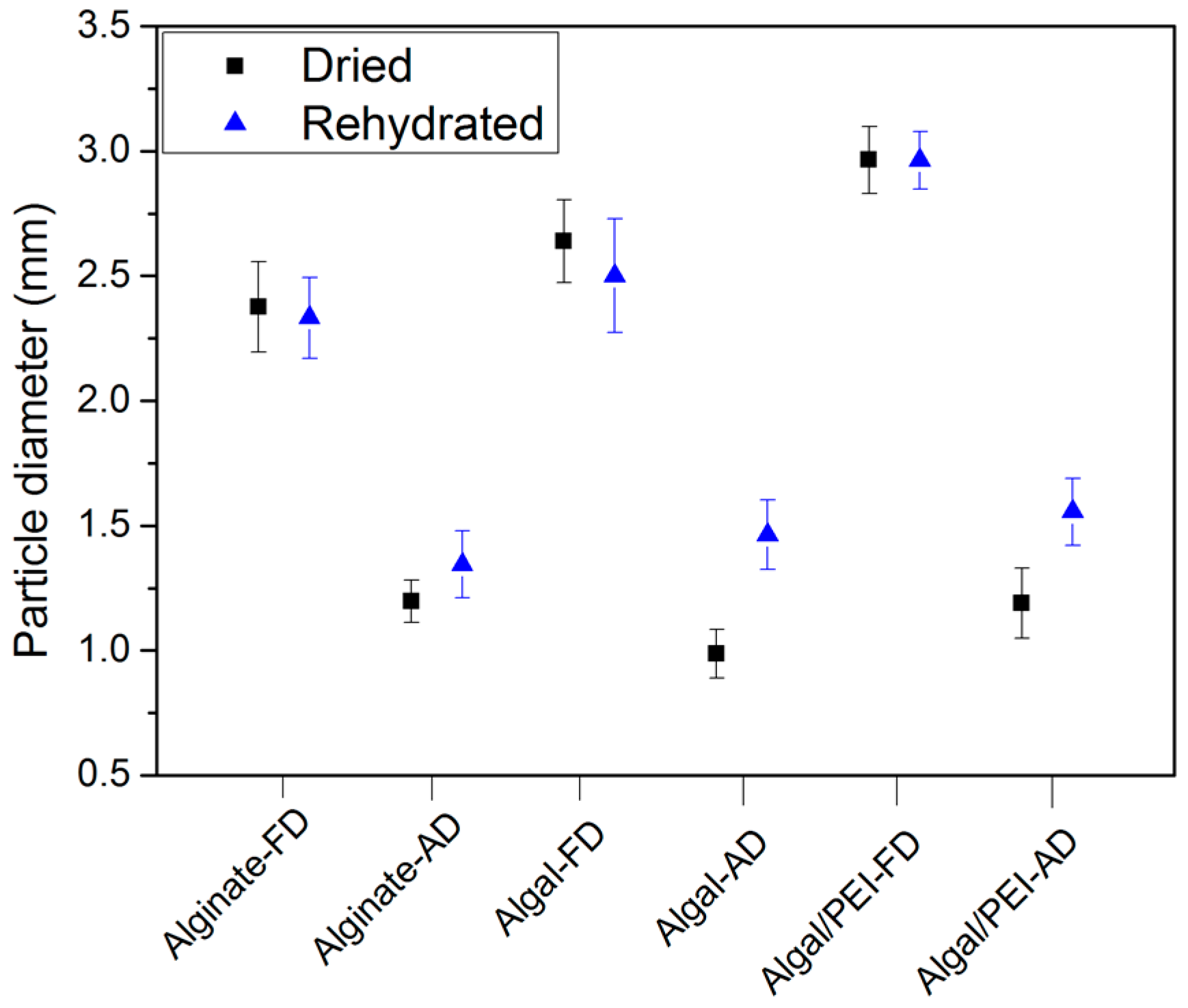
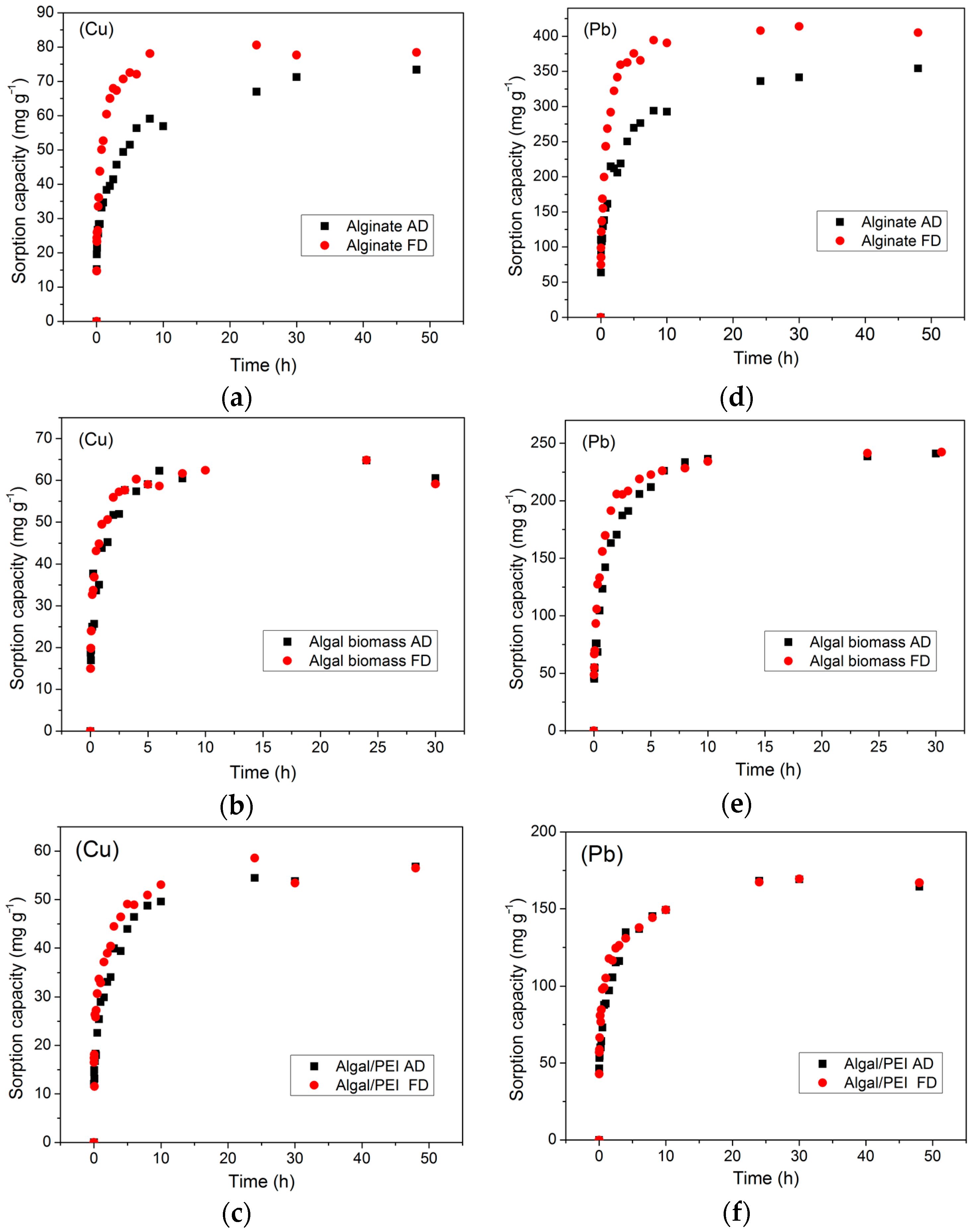
| Chitosan-Based Sorbents | |||||||
| Sorbents | qm for Cu(II) | qm for Pb(II) | pH | Sorbent Particle Size | References | ||
| Chitosan-tripolyphosphate beads | 0.43 a | 0.28 a | 4.5 | <200 μm | [71] | ||
| Crosslinked chitosan | 2.06 a | 0.81 a | 6 for Cu(II); 5 for Pb(II) | 100–150 μm | [72] | ||
| Chitosan-coated sand | 0.19 b | 0.11 b | – | 0.50 mm d | [73] | ||
| Cross-linked metal-imprinted Chitosan | 0.31 a | 0.36 a | 5 | 250–500 μm | [74] | ||
| Agriculture Wastes | |||||||
| Sorbents | qm for Cu(II) | qm for Pb(II) | pH | Sorbent Particle Size | References | ||
| Rosa bourbonia petals | 2.35 a | 0.69 a | 5 for Cu(II); 4.5 for Pb(II) | 0.25 mm d | [75] | ||
| Chemically modified orange peel | 0.24 a | 0.35 a | 5 | 0.2mm d | [76] | ||
| Cabbage waste | 0.20 b | 0.30 b | 6 | 75–300 μm | [77] | ||
| Non-modified Algal Biomass | |||||||
| Sorbents | qm for Cu(II) | qm for Pb(II) | pH | Sorbent Particle Size | References | ||
| Posidonia oceanica | – | 0.53 a | 5 | <125 μm | [78] | ||
| Padina sp. | 1.14 a | 1.25 a | 5 | 0.5–0.8 mm | [14] | ||
| Caulerpa lentillifera | 0.67 a | 0.12 a | 4 | 0.9 mm d | [12] | ||
| Ulva fasciata | 1.57 a | – | 5.5 | 0.5 mm d | [57] | ||
| Spirogyra sp. | 0.61 a | 0.44 a | 5 | 150–250 mesh | [79] | ||
| Gelidium sp. | 0.52 a | – | 5.3 | 0.25–1 mm | [17] | ||
| U. lactuca | – | 0.61 b | 4.5 | – | [11] | ||
| Fucus vesiculosus | 1.66 a | 1.02 a | 5 | <0.5 mm | [16] | ||
| G. oblongata | 0.43 b | 5 | 500–850 mm | [10] | |||
| Padina sp. | 1.14 a | 1.25 a | 5 | 0.5–0.8 mm | [14] | ||
| Kappaphycus alvarezii | 0.47 a | 0.51 a | 4.5 | 0.75 mm d | [80] | ||
| Modified Algal Biomass | |||||||
| Sorbents | qm for Cu(II) | qm for Pb(II) | pH | Treatment | Sorbent Particle Size | References | |
| Laminaria japonica | – | 1.52 c | 5.3 | KMnO4 | 0.3–0.45 mm | [56] | |
| Cystoseira barbata | – | 1.10 a | 4 | CaCl2 | 0.6–1.0 mm | [81] | |
| Green algae (unspecified species) | – | 0.48 a | 5 | Dimethyl sulfoxide (DMSO) | <0.75 μm | [82] | |
| Ulva lactuca | 0.16 a | 0.23 a | 5.5 | Immobilization into agar beads | – | [83] | |
| Algal biomass (Fucus vesiculosus) beads | 0.62 a | 2.3 a | 5 | Alginate e | – | [84] | |
| Alginate beads | 1.76 b | 2.00 b | 4 | Homogeneous ionotropic gelation f | 2.4 mm d | This study | |
| Algal biomass (Laminaria digitata) beads | 1.20 b | 1.43 b | 4 | Idem g | 2.6 mm d | This study | |
| Algal/PEI beads | 1.06 b | 1.05 b | 4 | Idem g | 3.0 mm d | This study | |
Acknowledgments
Author Contributions
Conflicts of Interest
References
- European Commission. European Commission. Council Directive 98/83/EC of 3 November 1998 on the quality of water intended for human consumption. In Document N° 01998L0083-20151027; European Union: Brussels, Belgium, 1998. [Google Scholar]
- Ekvall, T.; Hirschnitz-Garbers, M.; Eboli, F.; Sniegocki, A. A systemic and systematic approach to the development of a policy mix for material resource efficiency. Sustainability 2016, 8, 373. [Google Scholar] [CrossRef]
- Gaballah, I.; Kanari, N. Recycling policy in the European Union. JOM 2001, 53, 24–27. [Google Scholar] [CrossRef]
- Choi, G.-G.; Oh, S.-J.; Lee, S.-J.; Kim, J.-S. Production of bio-based phenolic resin and activated carbon from bio-oil and biochar derived from fast pyrolysis of palm kernel shells. Bioresour. Technol. 2015, 178, 99–107. [Google Scholar] [CrossRef] [PubMed]
- Xia, L.; Xu, X.; Zhu, W.; Huang, Q.; Chen, W. A comparative study on the biosorption of Cd2+ onto Paecilomyces lilacinus XLA and Mucoromycote sp XLC. Int. J. Mol. Sci. 2015, 16, 15670–15687. [Google Scholar] [CrossRef] [PubMed]
- He, J.; Chen, J.P. A comprehensive review on biosorption of heavy metals by algal biomass: Materials, performances, chemistry, and modeling simulation tools. Bioresour. Technol. 2014, 160, 67–78. [Google Scholar] [CrossRef] [PubMed]
- Bang, S.; Choi, J.-W.; Cho, K.; Chung, C.; Kang, H.; Hong, S.W. Simultaneous reduction of copper and toxicity in semiconductor wastewater using protonated alginate beads. Chem. Eng. J. 2016, 288, 525–531. [Google Scholar] [CrossRef]
- Humelnicu, D.; Ignat, M.; Doroftei, F. Agricultural by-products as low-cost sorbents for the removal of heavy metals from dilute wastewaters. Environ. Monit. Assess. 2015. [Google Scholar] [CrossRef] [PubMed]
- Mata, Y.N.; Blazquez, M.L.; Ballester, A.; Gonzalez, F.; Munoz, J.A. Sugar-beet pulp pectin gels as biosorbent for heavy metals: Preparation and determination of biosorption and desorption characteristics. Chem. Eng. J. 2009, 150, 289–301. [Google Scholar] [CrossRef]
- Ibrahim, W.M. Biosorption of heavy metal ions from aqueous solution by red macroalgae. J. Hazard. Mater. 2011, 192, 1827–1835. [Google Scholar] [CrossRef] [PubMed]
- Jalali, R.; Ghafourian, H.; Asef, Y.; Davarpanah, S.J.; Sepehr, S. Removal and recovery of lead using nonliving biomass of marine algae. J. Hazard. Mater. 2002, 92, 253–262. [Google Scholar] [CrossRef] [PubMed]
- Pavasant, P.; Apiratikul, R.; Sungkhum, V.; Suthiparinyanont, P.; Wattanachira, S.; Marhaba, T.F. Biosorption of Cu2+, Cd2+, Pb2+, and Zn2+ using dried marine green macroalga Caulerpa lentillifera. Bioresour. Technol. 2006, 97, 2321–2329. [Google Scholar] [CrossRef] [PubMed]
- Romera, E.; Gonzalez, F.; Ballester, A.; Blazquez, M.L.; Munoz, J.A. Comparative study of biosorption of heavy metals using different types of algae. Bioresour. Technol. 2007, 98, 3344–3353. [Google Scholar] [CrossRef] [PubMed]
- Sheng, P.X.; Ting, Y.P.; Chen, J.P.; Hong, L. Sorption of lead, copper, cadmium, zinc, and nickel by marine algal biomass: Characterization of biosorptive capacity and investigation of mechanisms. J. Colloid Interface Sci. 2004, 275, 131–141. [Google Scholar] [CrossRef] [PubMed]
- Singh, A.; Kumar, D.; Gaur, J.P. Copper(II) and lead(II) sorption from aqueous solution by non-living Spirogyra neglecta. Bioresour. Technol. 2007, 98, 3622–3629. [Google Scholar] [CrossRef] [PubMed]
- Mata, Y.N.; Blazquez, M.L.; Ballester, A.; Gonzalez, F.; Munoz, J.A. Characterization of the biosorption of cadmium, lead and copper with the brown alga Fucus vesiculosus. J. Hazard. Mater. 2008, 158, 316–323. [Google Scholar] [CrossRef] [PubMed]
- Vilar, V.J.P.; Botelho, C.M.S.; Boaventura, R.A.R. Copper removal by algae Gelidium, agar extraction algal waste and granulated algal waste: Kinetics and equilibrium. Bioresour. Technol. 2008, 99, 750–762. [Google Scholar] [CrossRef] [PubMed]
- Davis, T.A.; Volesky, B.; Vieira, R.H.S.F. Sargassum seaweed as biosorbent for heavy metals. Water Res. 2000, 34, 4270–4278. [Google Scholar] [CrossRef]
- Kawai, S.; Murata, K. Biofuel production based on carbohydrates from both brown and red macroalgae: Recent developments in key biotechnologies. Int. J. Mol. Sci. 2016, 17, 145. [Google Scholar] [CrossRef] [PubMed] [Green Version]
- Deze, E.G.; Papageorgiou, S.K.; Favvas, E.P.; Katsaros, F.K. Porous alginate aerogel beads for effective and rapid heavy metal sorption from aqueous solutions: Effect of porosity in Cu2+ and Cd2+ ion sorption. Chem. Eng. J. 2012, 209, 537–546. [Google Scholar] [CrossRef]
- Papageorgiou, S.K.; Kouvelos, E.P.; Katsaros, F.K. Calcium alginate beads from Laminaria digitata for the removal of Cu+2 and Cd+2 from dilute aqueous metal solutions. Desalination 2008, 224, 293–306. [Google Scholar] [CrossRef]
- Schiewer, S.; Patil, S.B. Pectin-rich fruit wastes as biosorbents for heavy metal removal: Equilibrium and kinetics. Bioresour. Technol. 2008, 99, 1896–1903. [Google Scholar] [CrossRef] [PubMed]
- Feng, D.; Aldrich, C. Adsorption of heavy metals by biomaterials derived from the marine alga Ecklonia maxima. Hydrometallurgy 2004, 73, 1–10. [Google Scholar] [CrossRef]
- Khataee, A.R.; Vafaei, F.; Jannatkhah, M. Biosorption of three textile dyes from contaminated water by filamentous green algal Spirogyra sp.: Kinetic, isotherm and thermodynamic studies. Int. Biodeterior. Biodegrad. 2013, 83, 33–40. [Google Scholar] [CrossRef]
- Guibal, E. Interactions of metal ions with chitosan-based sorbents: A review. Sep. Purif. Technol. 2004, 38, 43–74. [Google Scholar] [CrossRef]
- Huang, R.H.; Du, Y.M.; Yang, J.H. Preparation and in vitro anticoagulant activities of alginate sulfate and its quaterized derivatives. Carbohydr. Polym. 2003, 52, 19–24. [Google Scholar]
- Vincent, T.; Taulemesse, J.-M.; Dauvergne, A.; Chanut, T.; Testa, F.; Guibal, E. Thallium(I) sorption using Prussian blue immobilized in alginate capsules. Carbohydr. Polym. 2014, 99, 517–526. [Google Scholar] [CrossRef] [PubMed]
- Vincent, T.; Vincent, C.; Barre, Y.; Guari, Y.; Le Saout, G.; Guibal, E. Immobilization of metal hexacyanoferrates in chitin beads for cesium sorption: Synthesis and characterization. J. Mater. Chem. A 2014, 2, 10007–10021. [Google Scholar] [CrossRef]
- Guibal, E.; Vincent, T.; Jouannin, C. Immobilization of extractants in biopolymer capsules for the synthesis of new resins: A focus on the encapsulation of tetraalkyl phosphonium ionic liquids. J. Mater. Chem. 2009, 19, 8515–8527. [Google Scholar] [CrossRef]
- Nitta, S.K.; Numata, K. Biopolymer-based nanoparticles for drug/gene delivery and tissue engineering. Int. J. Mol. Sci. 2013, 14, 1629–1654. [Google Scholar] [CrossRef] [PubMed]
- Hassan, A.F.; Abdel-Mohsen, A.M.; Fouda, M.M.G. Comparative study of calcium alginate, activated carbon, and their composite beads on methylene blue adsorption. Carbohydr. Polym. 2014, 102, 192–198. [Google Scholar] [CrossRef] [PubMed]
- Idris, A.; Ismail, N.S.M.; Hassan, N.; Misran, E.; Ngomsik, A.-F. Synthesis of magnetic alginate beads based on maghemite nanoparticles for Pb(II) removal in aqueous solution. J. Ind. Eng. Chem. 2012, 18, 1582–1589. [Google Scholar] [CrossRef]
- Wang, X.; Zhu, K.-X.; Zhou, H.-M. Immobilization of glucose oxidase in alginate-chitosan microcapsules. Int. J. Mol. Sci. 2011, 12, 3042–3054. [Google Scholar] [CrossRef] [PubMed]
- Jung, K.-W.; Jeong, T.-U.; Kang, H.-J.; Ahn, K.-H. Characteristics of biochar derived from marine macroalgae and fabrication of granular biochar by entrapment in calcium-alginate beads for phosphate removal from aqueous solution. Bioresour. Technol. 2016, 211, 108–116. [Google Scholar] [CrossRef] [PubMed]
- Zhao, Y.; Carvajal, M.T.; Won, Y.-Y.; Harris, M.T. Preparation of calcium alginate microgel beads in an electrodispersion reactor using an internal source of calcium carbonate nanoparticles. Langmuir 2007, 23, 12489–12496. [Google Scholar] [CrossRef] [PubMed]
- Chen, H.B.; Wang, Y.Z.; Sanchez-Soto, M.; Schiraldi, D.A. Low flammability, foam-like materials based on ammonium alginate and sodium montmorillonite clay. Polymer 2012, 53, 5825–5831. [Google Scholar] [CrossRef]
- Song, H.; Yu, W.; Gao, M.; Liu, X.; Ma, X. Microencapsulated probiotics using emulsification technique coupled with internal or external gelation process. Carbohydr. Polym. 2013, 96, 181–189. [Google Scholar] [CrossRef] [PubMed]
- Lorbeer, A.J.; Lahnstein, J.; Bulone, V.; Trung, N.; Zhang, W. Multiple-response optimization of the acidic treatment of the brown alga Ecklonia radiata for the sequential extraction of fucoidan and alginate. Bioresour. Technol. 2015, 197, 302–309. [Google Scholar] [CrossRef] [PubMed]
- Castro-Cesena, A.B.; del Pilar Sanchez-Saavedra, M. Evaluation of sodium tripolyphosphate-alginate coating and re-calcifying on the entrapment of microalgae in alginate beads. J. Appl. Phycol. 2015, 27, 1205–1212. [Google Scholar] [CrossRef]
- Filippino, K.C.; Mulholland, M.R.; Bott, C.B. Phycoremediation strategies for rapid tertiary nutrient removal in a waste stream. Algal Res. 2015, 11, 125–133. [Google Scholar] [CrossRef]
- Ruiz-Marin, A.; Mendoza-Espinosa, L.G.; Stephenson, T. Growth and nutrient removal in free and immobilized green algae in batch and semi-continuous cultures treating real wastewater. Bioresour. Technol. 2010, 101, 58–64. [Google Scholar] [CrossRef] [PubMed]
- Kuncoro, E.P.; Roussy, J.; Guibal, E. Mercury recovery by polymer-enhanced ultrafiltration: Comparison of chitosan and poly(ethylenimine) used as macroligand. Sep. Sci. Technol. 2005, 40, 659–684. [Google Scholar] [CrossRef]
- Ruiz, M.; Sastre, A.; Guibal, E. Pd and Pt recovery using chitosan gel beads. II. Influence of chemical modifications on sorption properties. Sep. Sci. Technol. 2002, 37, 2385–2403. [Google Scholar] [CrossRef]
- Bertagnolli, C.; Grishin, A.; Vincent, T.; Guibal, E. Recovering heavy metal ions from complex solutions using polyethylenimine derivatives encapsulated in alginate matrix. Ind. Eng. Chem. Res. 2016, 55, 2461–2470. [Google Scholar] [CrossRef]
- Bertagnolli, C.; Grishin, A.; Vincent, T.; Guibal, E. Synthesis and application of a novel sorbent (tannic acid-grafted-polyethyleneimine encapsulated in alginate beads) for heavy metal removal. Sep. Sci. Technol. 2015, 50, 2897–2906. [Google Scholar]
- Alfaro-Cuevas-Villanueva, R.; Hidalgo-Vazquez, A.R.; Cortes Penagos, C.d.J.; Cortes-Martinez, R. Thermodynamic, kinetic, and equilibrium parameters for the removal of lead and cadmium from aqueous solutions with calcium alginate beads. Sci. World J. 2014, 2014, 647512. [Google Scholar] [CrossRef] [PubMed]
- Chen, J.P.; Tendeyong, F.; Yiacoumi, S. Equilibrium and kinetic studies of copper ion uptake by calcium alginate. Environ. Sci. Technol. 1997, 31, 1433–1439. [Google Scholar] [CrossRef]
- Plazinski, W. Sorption of lead, copper, and cadmium by calcium alginate: Metal binding stoichiometry and the pH effect. Environ. Sci. Pollut. Res. 2012, 19, 3516–3524. [Google Scholar] [CrossRef] [PubMed]
- Shang, Y.X.; Yu, X.F. Screening of algae material as a filter for heavy metals in drinking water. Algal Res. 2015, 12, 258–261. [Google Scholar] [CrossRef]
- Hammes, F.; Seka, A.; de Kniff, S.; Verstraete, W. A novel approach to calcium removal from calcium-rich industrial wastewater. Water Res. 2003, 37, 699–704. [Google Scholar] [CrossRef]
- Haug, A. Dissociation of alginic acid. Acta Chem. Scand. 1961, 15, 950–952. [Google Scholar] [CrossRef]
- Wang, F.; Lu, X.; Li, X.-y. Selective removals of heavy metals (Pb2+, Cu2+, and Cd2+) from wastewater by gelation with alginate for effective metal recovery. J. Hazard. Mater. 2016, 308, 75–83. [Google Scholar] [CrossRef] [PubMed]
- Papageorgiou, S.K.; Katsaros, F.K.; Kouvelos, E.P.; Nolan, J.W.; Le Deit, H.; Kanellopoulos, N.K. Heavy metal sorption by calcium alginate beads from Laminaria digitata. J. Hazard. Mater. 2006, 137, 1765–1772. [Google Scholar] [CrossRef] [PubMed]
- Pearson, R.G. Acids and bases. Science 1966, 151, 172–177. [Google Scholar] [CrossRef] [PubMed]
- Guibal, E.; Cambe, S.; Bayle, S.; Taulemesse, J.-M.; Vincent, T. Silver/chitosan/cellulose fibers foam composites: From synthesis to antibacterial properties. J. Colloid Interface Sci. 2013, 393, 411–420. [Google Scholar] [CrossRef] [PubMed]
- Rincon, J.; Gonzalez, F.; Ballester, A.; Blazquez, M.L.; Munoz, J.A. Biosorption of heavy metals by chemically-activated alga Fucus vesiculosus. J. Chem. Technol. Biotechnol. 2005, 80, 1403–1407. [Google Scholar] [CrossRef]
- Karthikeyan, S.; Balasubramanian, R.; Iyer, C.S.P. Evaluation of the marine algae Ulva fasciata and Sargassum sp for the biosorption of Cu(II) from aqueous solutions. Bioresour. Technol. 2007, 98, 452–455. [Google Scholar] [CrossRef] [PubMed]
- Kirupha, S.D.; Kalaivani, S.; Vidhyadevi, T.; Premkumar, P.; Baskaralingam, P.; Sivanesan, S.; Ravikumar, L. Effective removal of heavy metal ions from aqueous solutions using a new chelating resin poly 2,5-(1,3,4-thiadiazole)-benzalimine : Kinetic and thermodynamic study. J. Water Reuse Desalination 2016, 6, 310–324. [Google Scholar] [CrossRef]
- Fu, L.; Shuang, C.; Liu, F.; Li, A.; Li, Y.; Zhou, Y.; Song, H. Rapid removal of copper with magnetic poly-acrylic weak acid resin: Quantitative role of bead radius on ion exchange. J. Hazard. Mater. 2014, 272, 102–111. [Google Scholar] [CrossRef] [PubMed]
- Kolodynska, D.; Sofinska-Chmiel, W.; Mendyk, E.; Hubicki, Z. DOWEX M 4195 and LEWATIT® MonoPlus TP 220 in heavy metal ions removal from acidic streams. Sep. Sci. Technol. 2014, 49, 2003–2015. [Google Scholar] [CrossRef]
- Dubois, M.A.; Dozol, J.F.; Nicotra, C.; Serose, J.; Massiani, C. Pyrolysis and incineration of cationic and anionic ion-exchange resins-identification of volatile degradation compounds. J. Anal. Appl. Pyrolysis 1995, 31, 129–140. [Google Scholar] [CrossRef]
- Ho, Y.S.; McKay, G. Pseudo-second order model for sorption processes. Process Biochem. 1999, 34, 451–465. [Google Scholar] [CrossRef]
- Crank, J. The Mathematics of Diffusion, 2nd. ed.; Oxford University Press: Oxford, UK, 1975. [Google Scholar]
- Ruiz, M.; Sastre, A.; Guibal, E. Pd and Pt recovery using chitosan gel beads. I. influence of the drying process on diffusion properties. Sep. Sci. Technol. 2002, 37, 2143–2166. [Google Scholar] [CrossRef]
- Robitzer, M.; Tourrette, A.; Horga, R.; Valentin, R.; Boissiere, M.; Devoisselle, J.M.; di Renzo, F.; Quignard, F. Nitrogen sorption as a tool for the characterisation of polysaccharide aerogels. Carbohydr. Polym. 2011, 85, 44–53. [Google Scholar] [CrossRef] [Green Version]
- Marcus, Y. Ion Properties; Marcel Dekker, Inc.: New York, NY, USA, 1997; p. 259. [Google Scholar]
- McHugh, D.J. Food and Agriculture Organization of the United Nations. Available online: http://www.fao.org/3/a-x5822e/x5822e04.htm#chapter%202%20%20%20production,%20properties%20and%20uses%20of% (accessed on 5 July 2016).
- Bertagnolli, C.; Espindola, A.P.D.M.; Kleinuebing, S.J.; Tasic, L.; Carlos da Silva, M.G. Sargassum filipendula alginate from Brazil: Seasonal influence and characteristics. Carbohydr. Polym. 2014, 111, 619–623. [Google Scholar] [CrossRef] [PubMed]
- Agulhon, P.; Robitzer, M.; David, L.; Quignard, F. Structural regime identification in ionotropic alginate gels: Influence of the cation nature and alginate structure. Biomacromolecules 2012, 13, 215–220. [Google Scholar] [CrossRef] [PubMed]
- Haug, A. The affinity of some divalent metals to different types of alginates. Acta Chem. Scand. 1961, 15, 1794–1795. [Google Scholar] [CrossRef]
- Ngah, W.S.W.; Fatinathan, S. Adsorption characterization of Pb(II) and Cu(II) ions onto chitosan-tripolyphosphate beads: Kinetic, equilibrium and thermodynamic studies. J. Environ. Manag. 2010, 91, 958–969. [Google Scholar] [CrossRef] [PubMed]
- Laus, R.; Costa, T.G.; Szpoganicz, B.; Favere, V.T. Adsorption and desorption of Cu(II), Cd(II) and Pb(II) ions using chitosan crosslinked with epichlorohydrin-triphosphate as the adsorbent. J. Hazard. Mater. 2010, 183, 233–241. [Google Scholar] [CrossRef] [PubMed]
- Wan, M.-W.; Kan, C.-C.; Rogel, B.D.; Dalida, M.L.P. Adsorption of copper (II) and lead (II) ions from aqueous solution on chitosan-coated sand. Carbohydr. Polym. 2010, 80, 891–899. [Google Scholar] [CrossRef]
- Chen, C.-Y.; Yang, C.-Y.; Chen, A.-H. Biosorption of Cu(II), Zn(II), Ni(II) and Pb(II) ions by cross-linked metal-imprinted chitosans with epichlorohydrin. J. Environ. Manag. 2011, 92, 796–802. [Google Scholar] [CrossRef] [PubMed]
- Manzoor, Q.; Nadeem, R.; Iqbal, M.; Saeed, R.; Ansari, T.M. Organic acids pretreatment effect on Rosa bourbonia phyto-biomass for removal of Pb(II) and Cu(II) from aqueous media. Bioresour. Technol. 2013, 132, 446–452. [Google Scholar] [CrossRef] [PubMed]
- Lasheen, M.R.; Ammar, N.S.; Ibrahim, H.S. Adsorption/desorption of Cd(II), Cu(II) and Pb(II) using chemically modified orange peel: Equilibrium and kinetic studies. Solid State Sci. 2012, 14, 202–210. [Google Scholar] [CrossRef]
- Hossain, M.; Ngo, H.; Guo, W.; Nghiem, L.; Hai, F.; Vigneswaran, S.; Nguyen, T. Competitive adsorption of metals on cabbage waste from multi-metal solutions. Bioresour. Technol. 2014, 160, 79–88. [Google Scholar] [CrossRef] [PubMed]
- Allouche, F.-N.; Mameri, N.; Guibal, E. Pb(II) biosorption on Posidonia oceanica biomass. Chem. Eng. J. 2011, 168, 1174–1184. [Google Scholar] [CrossRef]
- Lee, Y.-C.; Chang, S.-P. The biosorption of heavy metals from aqueous solution by Spirogyra and Cladophora filamentous macroalgae. Bioresour. Technol. 2011, 102, 5297–5304. [Google Scholar] [CrossRef] [PubMed]
- Praveen, R.; Vijayaraghavan, K. Optimization of Cu(II), Ni(II), Cd(II) and Pb(II) biosorption by red marine alga Kappaphycus alvarezii. Desalination Water Treat. 2015, 55, 1816–1824. [Google Scholar] [CrossRef]
- Yalçın, S.; Sezer, S.; Apak, R. Characterization and lead(II), cadmium(II), nickel(II) biosorption of dried marine brown macro algae Cystoseira barbata. Environ. Sci. Pollut. Res. 2012, 19, 3118–3125. [Google Scholar] [CrossRef] [PubMed]
- Khan, T.A.; Mukhlif, A.A.; Khan, E.A.; Sharma, D.K. Isotherm and kinetics modeling of Pb(II) and Cd(II) adsorptive uptake from aqueous solution by chemically modified green algal biomass. Model. Earth Syst. Environ. 2016, 2, 1–13. [Google Scholar] [CrossRef]
- Areco, M.M.; Hanela, S.; Duran, J.; dos Santos Afonso, M. Biosorption of Cu(II), Zn(II), Cd(II) and Pb(II) by dead biomasses of green alga Ulva lactuca and the development of a sustainable matrix for adsorption implementation. J. Hazard. Mater. 2012, 213, 123–132. [Google Scholar] [CrossRef] [PubMed]
- Mata, Y.; Blázquez, M.; Ballester, A.; González, F.; Munoz, J. Biosorption of cadmium, lead and copper with calcium alginate xerogels and immobilized Fucus vesiculosus. J. Hazard. Mater. 2009, 163, 555–562. [Google Scholar] [CrossRef] [PubMed]
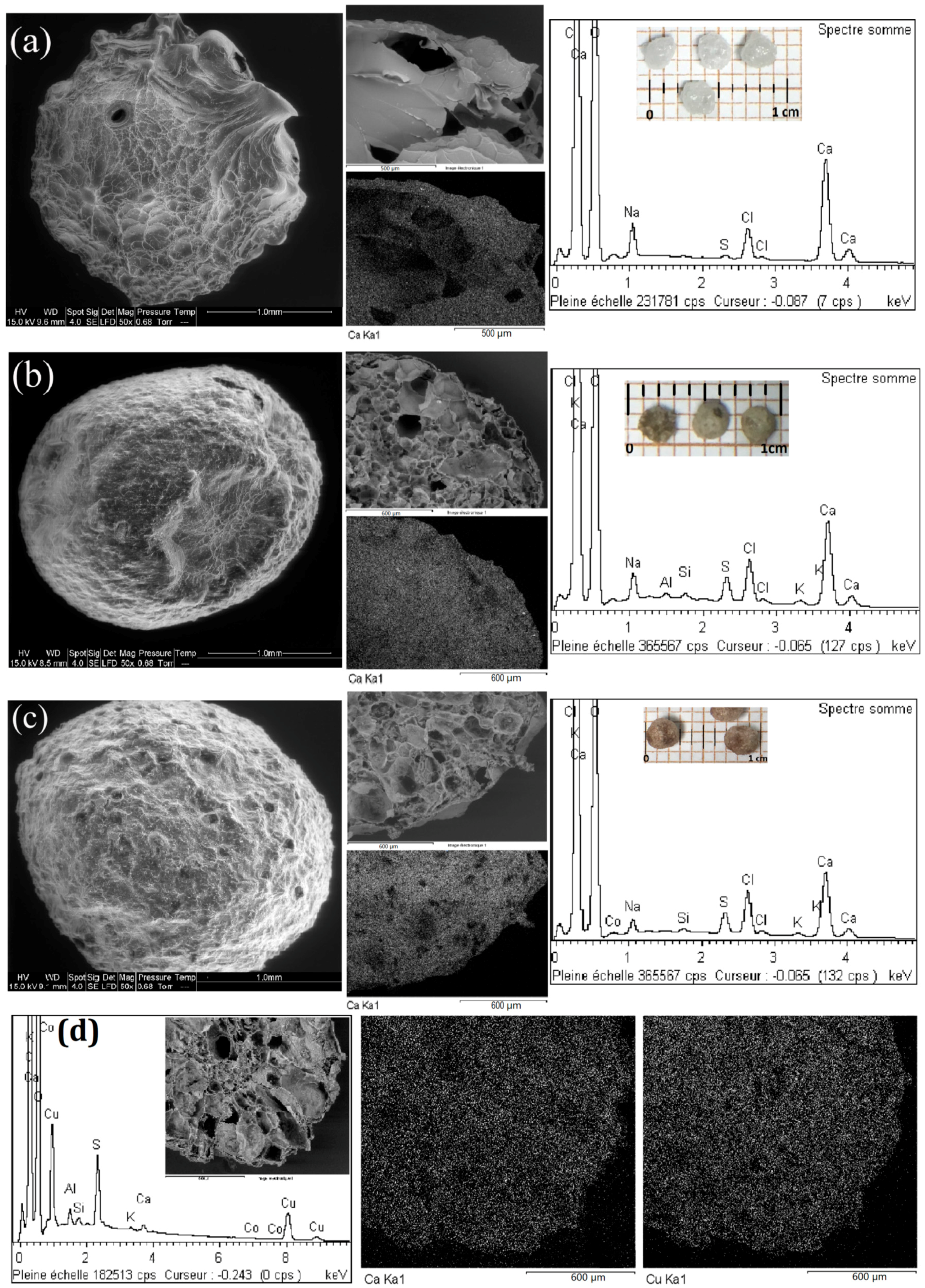

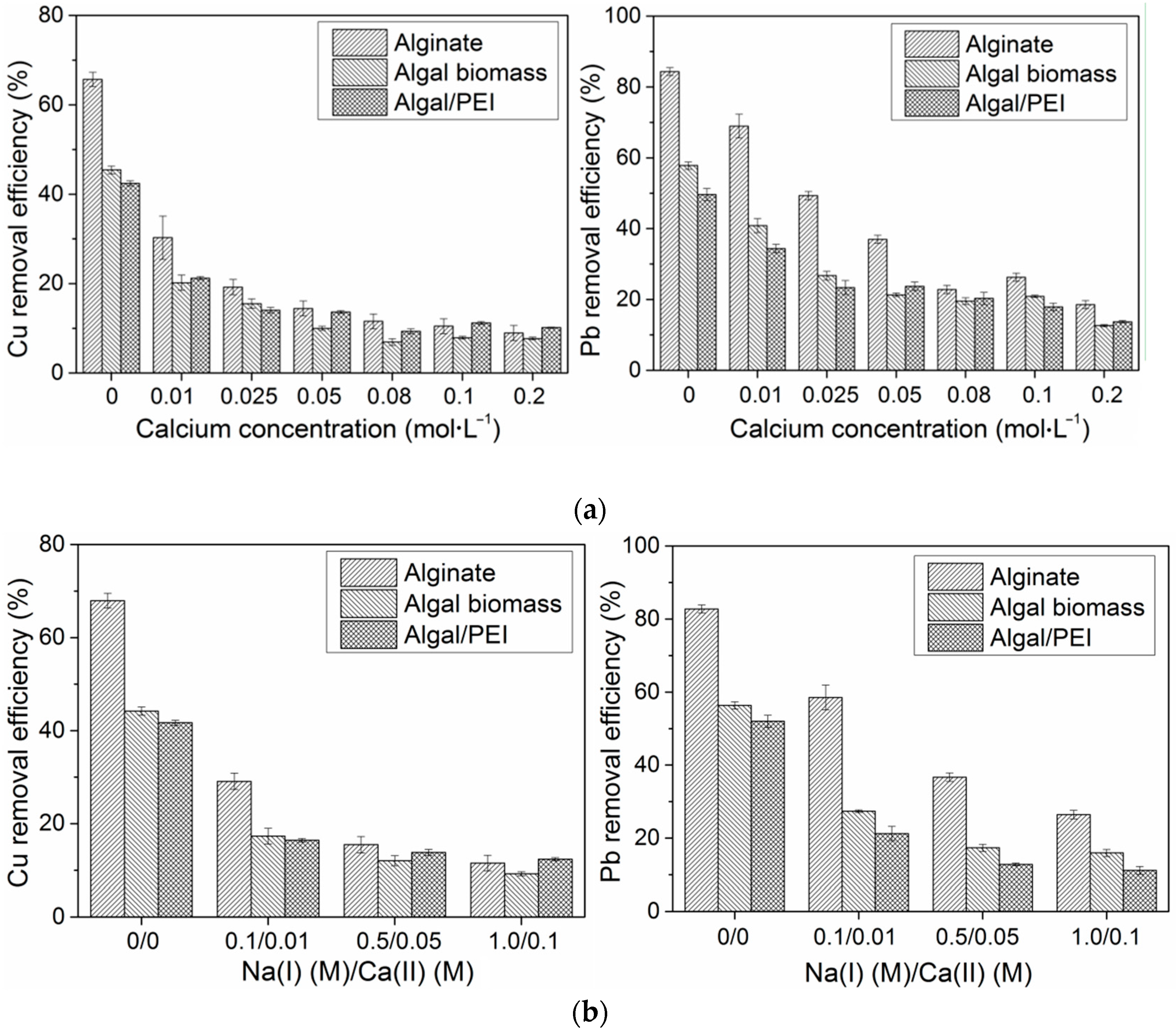
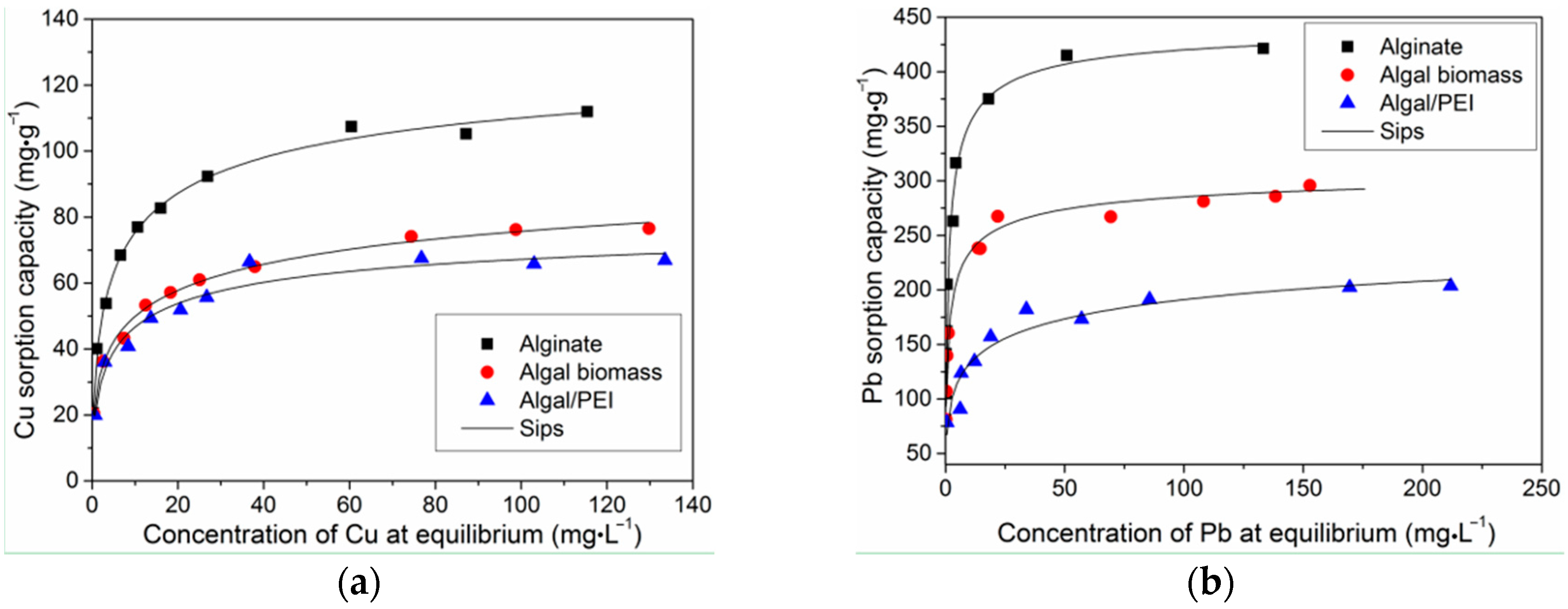
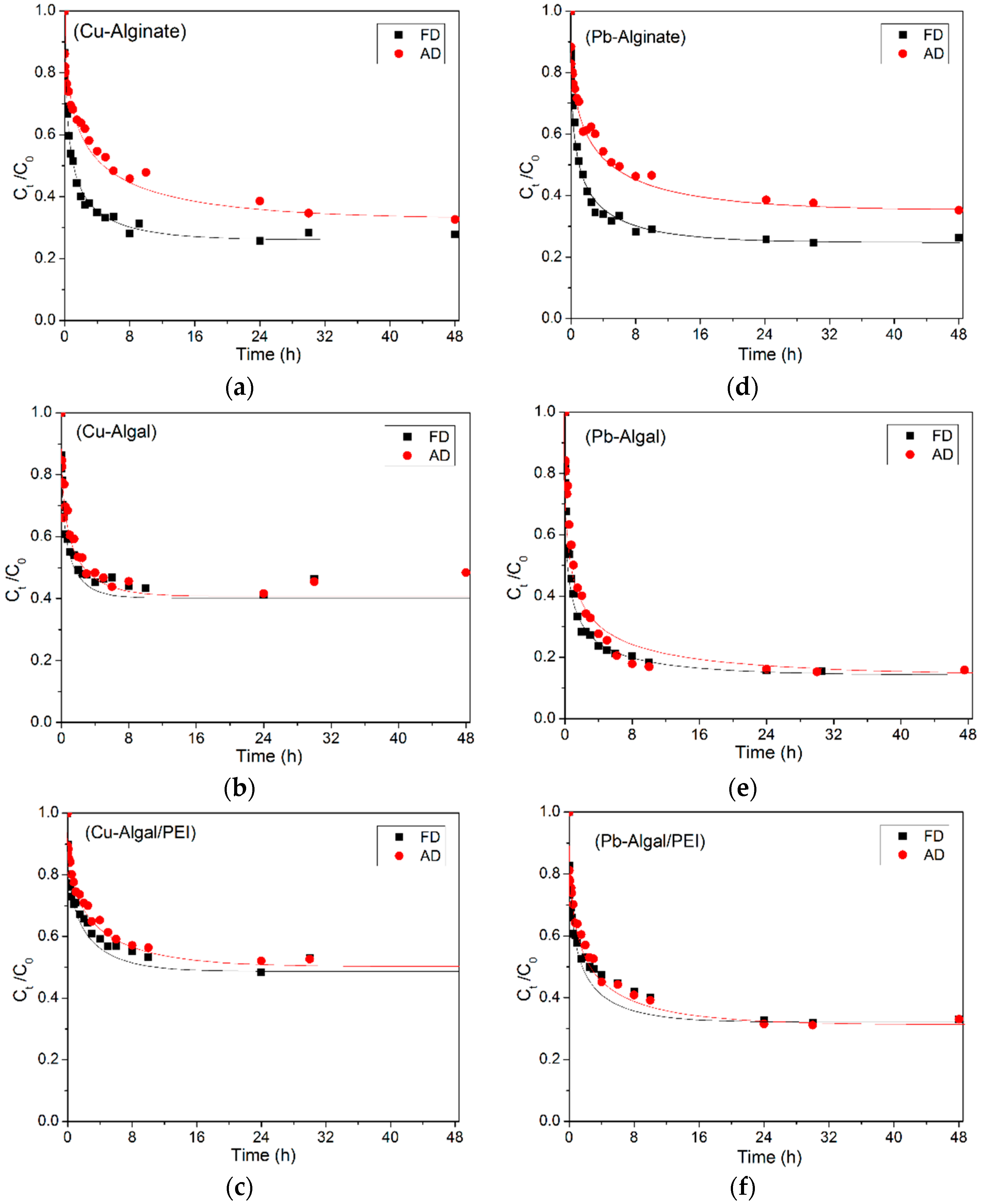
| Models | Parameters | Alginate | Algal Biomass | Algal/PEI | |||
|---|---|---|---|---|---|---|---|
| Pb(II) | Cu(II) | Pb(II) | Cu(II) | Pb(II) | Cu(II) | ||
| qm,exp | 414.8 | 111.9 | 295.8 | 76.5 | 217.5 | 67.5 | |
| qm,exp (a) | 2.00 | 1.76 | 1.43 | 1.20 | 1.05 | 1.06 | |
| Langmuir | qm | 390.3 | 107.5 | 264.2 | 74.5 | 201.4 | 66.3 |
| KL | 1.69 | 0.32 | 1.90 | 0.26 | 0.20 | 0.31 | |
| R2 | 0.94 | 0.93 | 0.85 | 0.87 | 0.71 | 0.88 | |
| x(10)2 | 35.4 | 14.3 | 12.9 | 12.9 | 5.3 | 7.4 | |
| Freundlich | KF | 195.9 | 43.1 | 144.3 | 30.4 | 89.5 | 28.9 |
| nF | 5.78 | 4.71 | 6.63 | 4.96 | 6.06 | 5.31 | |
| R2 | 0.88 | 0.95 | 0.88 | 0.97 | 0.88 | 0.90 | |
| x(10)2 | 61.7 | 8.4 | 15.4 | 1.9 | 6.1 | 4.8 | |
| Sips | qm | 454.8 | 138.4 | 337.8 | 116.7 | 315.9 | 82.9 |
| KS | 0.84 | 0.37 | 0.74 | 0.30 | 0.34 | 0.39 | |
| nS | 1.60 | 1.95 | 2.27 | 2.55 | 3.04 | 1.91 | |
| R2 | 0.98 | 0.99 | 0.96 | 0.99 | 0.91 | 0.95 | |
| x(10)2 | 12.0 | 0.3 | 3.9 | 0.4 | 4.3 | 1.6 | |
| Percent (%) | Metal | Contact Time (h) | |||||
|---|---|---|---|---|---|---|---|
| Alginate Beads | Algal Beads | Algal/PEI Beads | |||||
| AD | FD | AD | FD | AD | FD | ||
| 80 | Cu | 8 | 2 | 1.5 | 0.5 | 5 | 3 |
| Pb | 8 | 2 | 3 | 1.5 | 4 | 4 | |
| 99 | Cu | 48 | 8 | 8 | 8 | 48 | 24 |
| Pb | 30 | 24 | 24 | 24 | 24 | 24 | |
| Metal | De × 10−11 (m2·min−1) | |||||
|---|---|---|---|---|---|---|
| Alginate Beads | Algal Beads | Algal/PEI Beads | ||||
| AD | FD | AD | FD | AD | FD | |
| Cu | 3.5 | 22.4 | 1.8 | 8.8 | 1.0 | 6.1 |
| Pb | 4.3 | 17.6 | 2.4 | 13.5 | 0.95 | 4.4 |
© 2016 by the authors; licensee MDPI, Basel, Switzerland. This article is an open access article distributed under the terms and conditions of the Creative Commons Attribution (CC-BY) license (http://creativecommons.org/licenses/by/4.0/).
Share and Cite
Wang, S.; Vincent, T.; Faur, C.; Guibal, E. Alginate and Algal-Based Beads for the Sorption of Metal Cations: Cu(II) and Pb(II). Int. J. Mol. Sci. 2016, 17, 1453. https://doi.org/10.3390/ijms17091453
Wang S, Vincent T, Faur C, Guibal E. Alginate and Algal-Based Beads for the Sorption of Metal Cations: Cu(II) and Pb(II). International Journal of Molecular Sciences. 2016; 17(9):1453. https://doi.org/10.3390/ijms17091453
Chicago/Turabian StyleWang, Shengye, Thierry Vincent, Catherine Faur, and Eric Guibal. 2016. "Alginate and Algal-Based Beads for the Sorption of Metal Cations: Cu(II) and Pb(II)" International Journal of Molecular Sciences 17, no. 9: 1453. https://doi.org/10.3390/ijms17091453







